CONTENTS
"Best I Ever Saw"
Herb and St. Jude
Cubs-Giants 1908 – I
Cubs-Giants 1908 – II
Louisiana War Hero Returns
Curse of the Colonel
Brought Together by Tragedy
Baseball
Vignettes Index
Baseball
Magazine
Golden Rankings Home
Top of Page
|
Baseball Vignettes - X
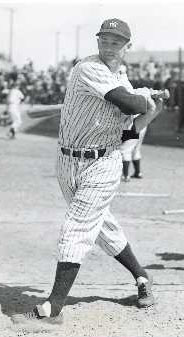
Joe Gordon |
"The greatest all-around player I ever saw, and I don't bar any of them, is Joe Gordon." That startling statement was made by Joe McCarthy, Hall of Fame manager of the Yankees and Red Sox. Perhaps McCarthy's opinion persuaded the veterans committee to elect Gordon to the Hall of Fame for 2009 induction.
- Joe was a power-hitting 2B, a rare combination during his career from 1938-1950. He hit 253 HRs for the Yankees (1938-1946, with two years out for World War II in 1944-5) and the Cleveland Indians (1947-1950). His career batting average was .268.
- He won the AL MVP in 1942 when he hit .322 and drove in 103.
- Gordon played on four Yankees pennant winners: 1938, 1941, 1942, and 1943. He also helped the Indians win the World Series in 1948 with 32 HRs and 124 RBI.
- Joe had hits that prolonged two of baseball's most famous rallies in 1941.
- In the bottom of the ninth of the All-Star Game in Detroit, Gordon singled with one out and scored on Ted Williams' three-run walkoff HR.
- In Game 4 of the 1941 World Series at Ebbets Field, the Dodgers led 4-3 with two out and none on in the top of the ninth when Tommy Henrich struck out but reached first when C Mickey Owen missed the ball. Gordon doubled in the final two runs as the Yanks rallied for a 7-4 victory.
- Perhaps Gordon's best contribution to baseball was his treatment of the AL's first African-American player, Larry Doby, when he came to the Indians late in the 1947 season. Doby recalled that the Cleveland veterans refused to shake hands with him when he arrived, but when the players went out to warm up, Gordon said, "Let's have a catch." Now they're both in the Hall of Fame.
Reference: "Gordon, Overlooked Yankee, Gets His Due," Dave Anderson, New York Times, December 2008 |
|
Herb Score died in November 2008 at age 75. He exploded onto the AL scene in 1955 when he was voted Rookie of the Year. However, he was never the same after he was hit in the eye in 1957 by a liner off the bat of Gil McDougald of the Yankees. Yet Score faced adversity before and long after that accident.
- Herb's middle name was Jude. At age three, his legs were crushed by a bakery truck. The night before her son was to undergo an operation, the parish priest gave Mrs. Score a St. Jude medal. When her boy woke up the next morning, his legs had healed to the point that surgery wasn't necessary.
- Score had more than his share of illnesses and injuries by age 20: appendicitis, two broken ankles, bursitis, colitis, pneumonia, rheumatic fever (which cost him a year of school), and a separated shoulder. Yet he signed a pro contract and, at age 20, struck out 330 in AAA. At that point, the Reds offered the Indians $500,000 for him. Herb justified Cleveland's faith in him the next season by setting a rookie record for Ks. After his second year with the Indians, the Red Sox doubled the Reds' offer.
- As he lay on the field after McDougald's smash, Herb prayed, "Stay with me, St. Jude," as the P.A. announcer called for a doctor. McDougald promised to retire from baseball if Score lost his sight. VP Richard Nixon, among many others, sent a get-well message to the hospital. Cleveland newspapers ran updates on his condition under large headlines on the front page.
- Score regained his sight and returned to the mound for the '58 season. A three-hit, 13K shutout of Chicago in April provided hope that he was as good as before. But it was not to be. Fellow hurler Bob Lemon said that a line shot up the middle brought back old memories. Score himself maintained that the real problem was an elbow injury suffered shortly after the Chicago shutout. Whatever the reason, he never came close to his rookie form and retired after 1961.
- Herb by no means left baseball, however. He joined the Indians TV announcing team for 1964-7, then switched to radio from 1968 until his retirement in 1997. The last game he did was Game 7 of the 1997 World Series in which the Indians blew a lead in the ninth and lost in the 11th. It seemed a sadly fitting end to his star-crossed life in baseball.
- Even late in life, he needed St. Jude. In October 1998, while driving home to Florida after being inducted into the Broadcasters Hall of Fame, Score pulled into the path of a tractor-trailer in Ohio. He suffered trauma to his brain, chest and lungs. One orbital bone was broken along with three ribs and his sternum. He spent over a month in intensive care.
He fought through a difficult recovery to throw out the first pitch on Opening Day 1999 in Cleveland.
|
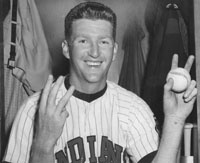
Herb Score
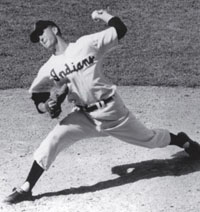

Herb Score on his retirement as
Indians broadcaster
Top of Page
|
|
One of the most famous games in baseball history was the 1908 clash between the Chicago Cubs and the New York Giants at the Polo Grounds on September 23 – the "Bonehead Merkle" game.
- With the score tied 1-1 in the bottom of the ninth, the Giants had Moose McCormick on third and Fred Merkle on first with two outs.
- Al Bridwell lined a single over 2B to score McCormick and send many of the 20,000 onto the field in delirium over a crucial win in a tight pennant race.
- But wait. Merkle didn't bother to touch second. Instead, with fans on the field, he set sail for the clubhouse in CF.
- Cubs 2B Johnny Evers screamed for the ball. However, the throw went over his head, landing near 3B coach Joe McGinnity.
- Joe, hip to what Evers had in mind, picked up the ball and threw it toward the grandstand. One Giant later claimed the toss went over the grandstand.
- The Cubs swore that one of their P, Floyd Kroh, went into the stands, retrieved the ball, and threw it to Evers.
- "The Crab" stepped on 2B and appealed to base umpire Hank O'Day that Merkle was forced out, ending the inning with the game still tied.
Evers had precedent for his claim.
- Earlier that month in a game against Pittsburgh, the same situation had occurred. Without the confusion of fans on the field, Evers had gotten hold of the ball and touched the bag.
- The same ump, O'Day, refused to nullify the run because he had not seen whether the runner touched second. As the sole arbiter that day, he had been watching the lead runner touch home.
- However, O'Day told Evers he was right – if the runner on first failed to touch second, he was forced out, nullifying the winning run.
Returning to the Merkle situation, plate umpire Bob Emslie consulted with O'Day.
- Hank said that "Merkle did not go near second base. I then called Merkle out and O'Day said the run did not count" (to quote the report Emslie submitted to League president Harry Pulliam the next day).
- In his report, O'Day said that "I did not ask to have the field cleared, as it was too dark to continue play."
- Pulliam, who had been in attendance, ruled it a tie game that was called because of darkness.
Neither team was happy with the ruling.
- The Cubs demanded a forfeit win because the Giants lost control of the crowd so that the game could not continue. In fact, they reported to the Polo Grounds early the next day for the last game of the series to indicate their willingness to either complete the suspended game or replay it as part of a DH.
- On the other side, New York manager John McGraw claimed that when Kroh, a player not in the game at the time, touched the ball, it became dead (an argument that would seem to have some legitimacy).
- Since the Giants had five days to reply to the ruling under league rules, Pulliam didn't order the game to be replayed the afternoon of his ruling. Instead, he ordered a makeup game at the end of the season should it be necessary to decide the pennant.
As it turned out, the Cubs and Giants ended the regular season with identical records. So they replayed the Merkle game on October 8. It was, in effect, a playoff game.
|
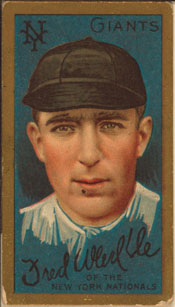
Fred Merkle

Johnny Evers
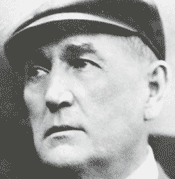
Hank O'Day

Harry Pulliam
Top of Page |
|
On Sunday, October 4, the Cubs ended their regular schedule with a victory over Pittsburgh to give them a record of 98-55. The Giants, at 95-55, must sweep a three-game series at home with the Boston Doves in order to tie Chicago. And that's exactly what they do, 8-1, 4-1, and 7-2. So on Thursday, October 8, the rested Cubs must meet the Giants at the Polo Grounds in a replay of the tie game of September 23.
- As early as 9 am, fans gather on Coogan's Bluff above the ballpark, climb up on the grandstand roof, and perch on the elevated train tracks behind LF. (One man falls from the el to his death.)
- At 11 am the box office opens. By noon, all the tickets are gone.
- At 2 pm, an hour before the game is scheduled to start, thousands of fans, after failing to set fire to it, tear open a 75-foot section of the OF fence and rush through the gap. Firehoses and mounted police repel the invasion, but many fans end up standing in the OF for the game.
- Some estimate the crowd in and around the ballpark at 40,000.
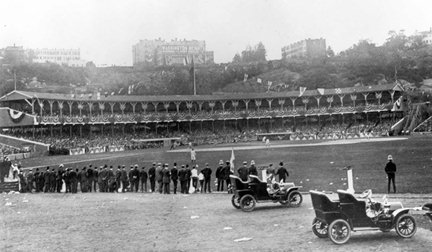
Polo Grounds during 1905 World Series
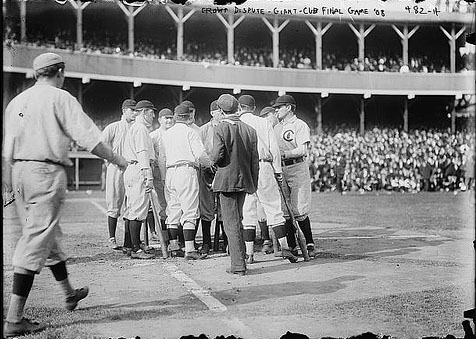
Giants-Cubs Confrontation before start of October 8 game
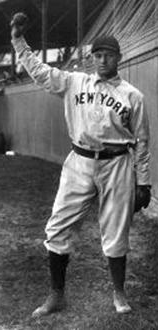
Joe McGinnity
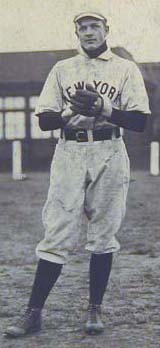
Christy Mathewson
Top of Page |
Neither the fans nor the Giants themselves are happy about playing the game. They feel they won the pennant by one game by virtue of their "victory" over the Cubs in the Merkle Game September 23. As a result, neither group is hospitable to the visiting team that "done 'em wrong."
- Thousands jeer the Cubs when their train arrives at Grand Central Station that morning after the 14-hour trip from Chicago.
- Mordecai Brown, the Chicago ace, Evers, and even Evers's mother have received death threats.
- The players have to push their way into the park, where they are allotted only 15 minutes to warm up because umpire Bill Klem accedes to the Giants request to start the game early because of the unruly throng.
- In some accounts, Giant P "Iron Joe" McGinnity goes up to Frank Chance, the Cubs' manager, cursing and spitting, trying unsuccessfully to start a fight that would get Chance thrown out before the game begins.
- Brown later said: "From the stands there was a steady roar of abuse. I never heard anybody ... called as many foul names as the Giants fans called us that day."
- Cubs C Johnny Kling, while chasing a pop foul during the game, dodges "two beer bottles, a drinking glass, and a derby hat."
Despite four days rest, Giants ace Christy Mathewson has a dead arm thanks to 110 September innings pitched. McGraw starts him anyway. Chance, cognizant that even with four days rest Brown is fatigued from pitching in 11 of the last 14 games, starts lefty Jack Pfiester. However, when Pfiester gives up a quick run in the first, Chance calls in Brown who quells the uprising.
Matty gets through two but falls apart in the third, surrendering four runs. He gamely stifles the Cubs the rest of the way, but Brown does the same to the Giants. As soon as the last out of the 4-2 victory is recorded, the Cubs race to the CF clubhouse but not fast enough. Pfiester is knifed in the shoulder, and Chance is punched so hard in the throat that he sustains broken cartilage. At least three other Chicagoans are struck, and the police have to hold the clubhouse doors shut with guns drawn.
The Cubs then defeat the Detroit Tigers in the World Series. Little do they know that it will be the franchise's last championship of the century. |

Mordecai Brown
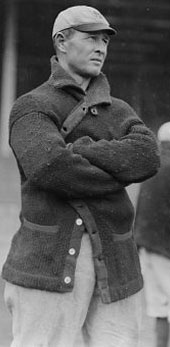
Frank Chance
|
References: Crazy '08, Cait Murphy
"Decades before Bartman, There Was Merkle," Kevin Baker, New York Times, September 23, 2008
|
Louisiana War Hero Returns
On June 14, 1947, while the Chicago White Sox were in Boston for a weekend series, the Red Sox traded 1B Rudy York to Chicago for 1B Jake Jones. In the Sunday doubleheader the next day, Jones belted two balls over the LF wall and drove in seven runs to help sweep his old team. In the nightcap, his walk-off grand slam broke a 4-4 tie.
In the Red Sox dugout, P Tex Hughson predicted Jones' game-winning blast as he walked to the plate. "He'll hit a HR on the first pitch." However, Jones nearly didn't get his grand slam. Bobby Doerr, on first when Jones delivered, ran to second, touched the bag, and headed to the clubhouse. However, Coach Del Baker waved to him, and Doerr realized that, even though the winning run had scored, the newcomer's HR was at stake. So he resumed his trip around the bases.
Red Sox manager Joe Cronin said, "I guess the trade is all right for tonight, at least." When someone said that Jones had a pretty good day, Boston IF Eddie Pellagrini replied: "Pretty good day! That's a pretty good week."
Considering what he had been involved with in the previous five years, it's remarkable that Jones was playing at all, much less hitting grand slams.
- Born near Monroe LA in 1920, Jones played in the Class C Cotton States League right out of high school. In 1940, he led the Class AA Texas League with 24 HRs at Shreveport. He also exhibited outstanding fielding ability at 1B. Detroit's Hall-of-Famer Harry Heilmann called Jones one of the greatest natural hitting prospects he had ever seen.
- Shreveport sold Jake to the White Sox in late August, 1941. He played in three games for Chicago that season and seven more at the beginning of 1942 before enlisting in the U.S. Navy.
- Selected for flight training, Jones was sent to Chapel Hill NC. The Navy baseball team there included Ted Williams, Johnny Pesky, Johnny Sain, Joe Coleman, Ray Scarborough, Buddy Hassett, and Harry Craft. However, Jake played only for the post basketball team.
- In 1944-5, while flying off the carrier Yorktown in the Pacific, Jones earned four Air Medals, several Distinguished Flying Crosses and a Silver Star for his bravery and efficiency on combat missions. On one flight, he downed five Japanese planes. (Jones' first Air Medal citation was signed by Vice Admiral J. S. McCain, grandfather of the 2008 Republican presidential candidate, Senator John McCain III.)
- As a result, Jones returned to the U.S. after the war as a hero. During a week's shore leave in NYC, he appeared on Kate Smith's radio show. The famous sportswriter Grantland Rice praised the flying skill of the former ballplayer. "It was over Tokyo that three flyers ganged up on him and he got all three."
|

Jake Jones |
Jake returned to the White Sox for the 1946 season. Although he had returned unscathed from WWII, he didn't have such luck on the diamond. He fractured his left wrist and elbow when Detroit's Eddie Lake ran into his outstretched arm during a play at 1B. Surgery and a long period of physical therapy got Jones in shape to play in 1947 and set the stage for his impressive debut with the Red Sox.
Unfortunately, Jake's first day with Boston gave a misleading view of his production. "Streaky as they come, Jones was capable of carrying the team when his bat was hot, but when it wasn't it could be freezing." He hit only .237 combined for the two Sox teams in 1947. However, he drove in 96 runs and clouted 19 HRs. Jake also developed a strong friendship with Ted Williams because of their common interest in fishing and flying.
When Cronin took over as GM in 1948, he hired Joe McCarthy as manager. Joe moved OF Stan Spence to 1B and platooned him with Jones. However, when neither provided the clout needed from the position, McCarthy turned to Billy Goodman. Jones hit .200 and 1 HR in only 105 ABs. After the season, the Red Sox released him, and he finished his baseball career with AAA Louisville and AA San Antonio in 1949 before retiring to his 400-acre cotton farm in his hometown.
Reference: "Ace: The Jake Jones Story," Dick Thompson, The National Pastime: A Review of Baseball History (SABR)
Top of Page
|
Do you believe in curses? The most famous is the Curse of the Bambino. But you may not have heard of the Curse of the Colonel.
- The Hanshin Tigers of Osaka, Japan, named for the Hanshin Electric Railway Co., began play in the Japanese baseball league in 1936. The Tigers won four titles before the establishment of the two league system in 1950. Since the league was split into the Central and Pacific Leagues, Hanshin has won the Central League pennant five times (1962, 1964, 1985, 2003, 2005).
- The Tigers won their only Japan Series title in 1985. Afterwards, celebrating fans gathered on the Ebisubashi Bridge over the Dotonbori River. In a ritual followed every time an Osaka team wins a sports championship, the fans chanted the names of the Tiger players. As each name was called, a fan resembling that player and wearing his jersey jumped from the bridge.
- However, no Oriental looked like the team's U.S. MVP, Randy Bass, who clouted 54 HRs that season. So the fans seized a Colonel Sanders statue from in front of a local KFC, dressed it in Bass's jersey, and threw it into the river.
- Some revelers, realizing what they had done, apologized to the store manager and promised to return the statue. However, when they searched the river the next day, the Colonel was nowhere to be found. Periodically since that time, divers were sent down and the river dredged in attempts to recover the statue, to no avail.
- Hanshin has not won the Japan Series since. Fans became convinced that the team would not win the championship again until the statue is recovered.
- Bass, who had signed with Hanshin in 1983 after playing for the Minnesota Twins, Texas Rangers, Kansas City Royals and the Montreal Expos, was not bothered by any jinx. He won four straight league batting titles and two consecutive triple crowns. He returns to Japan yearly for commercials, golf tournaments, autograph signings, and other such promotions
- A new development in the Curse of Colonel Sanders saga has just occurred. On March 9-10, 2009, workers cleaning the river bed found the parts of the statue and reassembled it.
- Bass, now a state senator in Oklahoma, proclaimed: "Now that they've found the Colonel, the curse is over, and it’s time to put your money on the Tigers."
|

Colonel Sanders Statue in Hanshin

Randy Bass holding the Japan Series MVP Trophy in 1985

Colonel Sanders statue recovered
Top of Page |
|
Brought Together by Tragedy
On March 4, 2007, Mike Coolbaugh and his friend Jay Maldonado went to Theodore Roosevelt High in San Antonio where both had starred on the diamond in the late 1980s. After 17 years in the minor leagues, Coolbaugh's only offer for the new season had come from a team in Tabasco, Mexico: $10,000 just to try out. So to prepare, he had brought Maldonado to throw him batting practice.
They set up the protective screen in front of the pitcher's mound. After Jay had been throwing an assortment of pitches for awhile as his father Jesse watched behind the batting cage, Coolbaugh ripped a liner up the middle. Maldonado didn't follow-through so that his head was not below the screen. He turned just in time to get hit behind his right ear. He dropped to the ground.
As he rushed to his son, Jesse Maldonado feared the worst. Finally, Jay sat up, having difficulty staying conscious. He sat with a distraught Coolbaugh on the bench until their breathing returned to normal. The ball left a large bruise, but Maldonado refused to see a doctor.
Coolbaugh had always feared that his wife or children would be hit by a ball lined or thrown into the stands. "He was more worried about it than anybody I've ever met," said his wife, Mandy. When he told her what had happened at the workout that morning, he fought back tears. "That can kill a guy," he said.
The Mexican team didn't offer Coolbaugh a contract. So he signed on as a coach with the Tulsa Drillers. One of his assignments was to coach first base. On July 22, 2007, he was struck in the back of the neck by a foul ball during a game in Little Rock and died almost instantly. He was 35.
Adding to the eerie coincidences, at least four people in the park that night had experienced the harm a thrown or batted ball can do.
- Bo McLaughlin, the Drillers' pitching coach, watched from the top step of the dugout. Coolbaugh's accident brought back painful memories. On May 26, 1981, when he was 27, he was struck in the face by a batted ball as he pitched for the Oakland A's against the Chicago White Sox. Harold Baines' liner shattered McLaughlin's left cheekbone, broke his eye socket in five places, and fractured his jaw and nose. He vomited five dugout towels' worth of blood and went into shock. Doctors at the hospital in Oakland weren't sure he would survive the night but he did. When all his injuries had healed sufficiently, he resumed pitching that September. He pitched for the A's in 1982, then bounced around Triple A for three more seasons before retiring.
- Bill Valentine, the GM of the Arkansas Travelers since 1976, saw the horrible Coolbaugh incident from the park's broadcast booth. He had been the home plate umpire the afternoon (August 18, 1967) that Red Sox RF Tony Conigliaro was hit in the left eye by a fastball from California Angels P Jack Hamilton. Conigliaro wore a batting helmet but not one with an ear flap. His retina was permanently damaged. Doctors told him that if the ball had hit two inches higher, he would not have survived. Valentine remembered that, as Tony lay in the dirt, "his whole face was swelling up, blood rushing in there. When he hit the ground his eye was completely shut. It was unbelievable." Conigliaro, who had been one of the best young players in the AL, earned Comeback Player of the Year in 1969, but then his eyesight started deteriorating rapidly, and he retired several years later.
- Warren Stephens, President and Chief Executive Officer of Stephens Inc. in Little Rock and a leading figure in the building of the Travelers new Dickey-Stephens Park that opened that season, watched Coolbaugh's death from his luxury box behind home plate. His late father, the chairman of Augusta National Golf Club, had been knocked out by a line drive while playing 3B at Columbia (TN) Military Academy in 1941. As a result, Warren was a nervous wreck the first time he took his kids to Yankee Stadium. "We're just past 3B but down really low, and I wouldn't take my eyes off of any pitch. I was scared we would get hammered." Now he had just witnessed a tragedy at the ballpark that was his pride and joy.
- Jon Asahina, a Tulsa P, had suffered a fractured skull from a batted ball on the same field three months earlier.
Reference: "Hit in the Head," S. L. Price, Sports Illustrated, 4/20/2009
|
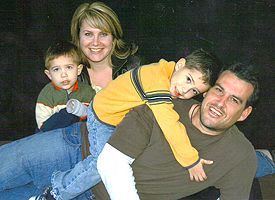
Mike Coolbaugh and family
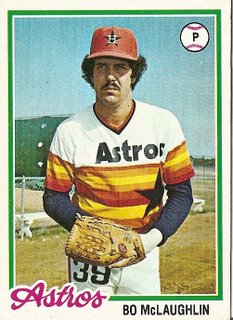
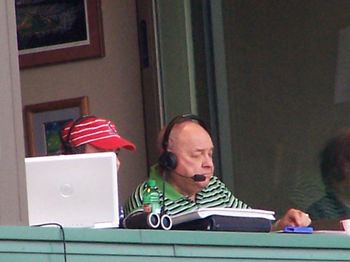
Bill Valentine

Warren Stephens
Top of Page |
|
|